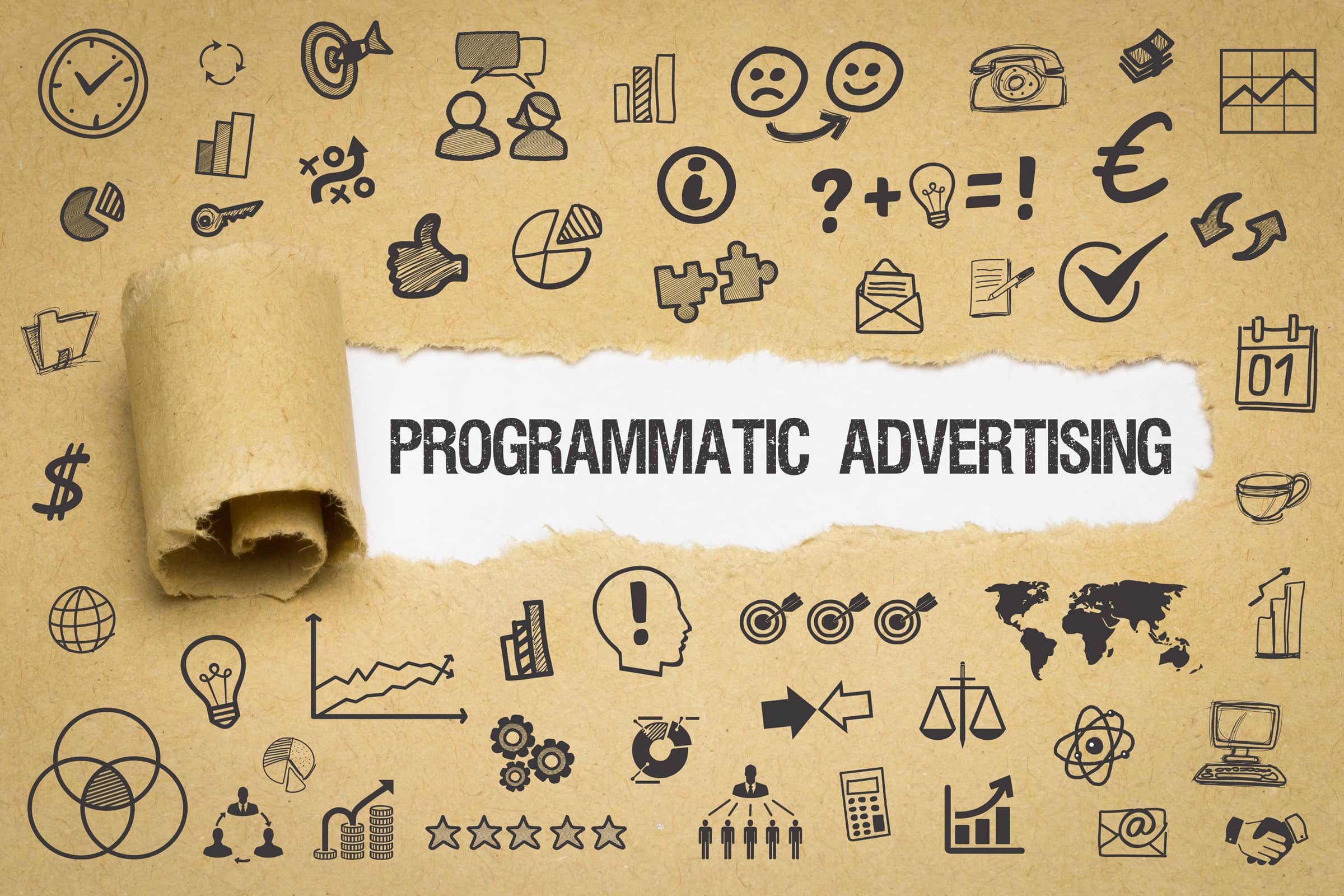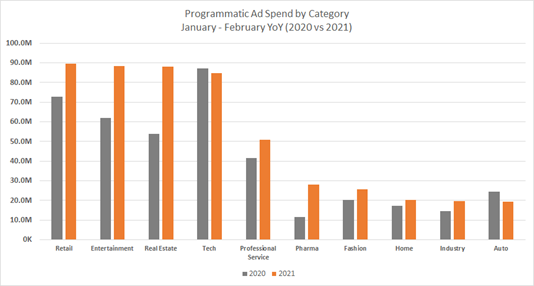Spending on programmatic advertising more than doubled worldwide from 2017 to 2021, rising from 68.2 billion to 155 billion in dollars spent. On average, spending has increased 21.75% over the past 4 years. If that average holds true, in 2022 advertising spend should hit around 188 billion dollars spent on programmatic advertising. As cross-device programmatic capabilities increase and connected devices per household continue to grow, it’s more than likely advertisers will hit that 188-billion-dollar mark. With more advertisers and marketers turning their dollars towards programmatic, it’s important to understand what programmatic advertising is and whether a portion of your marketing mix should be utilizing this growing technology.

A healthy marketing mix includes the 4 p’s, product, price, place, and promotion. In the following article, I’ll discuss how another P, programmatic, is a key piece of the promotion of a product. I’ll tell you what programmatic is, how it works, and some pros and cons. Next, I’ll look at some big brands using programmatic to point out their successes and failures. Finally, I’ll wrap up by briefly making a case for Coopersmith Digital’s solution which uses unstructured data instead of segmented data to give advertisers more insight, clarity, flexibility, and RoAS for each dollar invested.
What is Programmatic Advertising and is it the future?
Programmatic advertising uses automated technology to buy digital media advertising space. Depending on the service provider, this can be accomplished in several ways and on a number of different channels. Programmatic media buyers rely on algorithms, data insights, Geo-fencing technology and artificial intelligence to serve advertisements to potential customers. These advertisements are placed across connected devices (often referred to as inventory) including mobile, web display, video, pre-roll, connected TVs, radio, social media and in-app.
Programmatic advertising isn’t the future because the future is now. Backed by what’s anticipated to be nearly 200 billion dollars of spend in 2022, marketers are already spending nearly 20x what they spend in the affiliate marketing space and more than 10x what they spend on radio. For decades, marketers have known the importance of touch-points to a campaign and with programmatic they can increase the frequency of those touch-points for a fraction of the cost, compared to increasing radio, TV, and print touches.
How Does Programmatic Advertising Work?
Programmatic advertising all starts with data. Those apps installed on your phone and cookies on your favorite website are all collecting data about you. Apps can know your location, buying habits, income level, your location, and so much more. Data is collected, analyzed, and cataloged in order for advertisers, marketers, or artificial intelligence to build an audience for their advertising that’s more likely to convert. Wouldn’t it be invaluable as a realtor to know what homes in your city were searching for information about foreclosure so you could serve them an add about short-sale help to avoid foreclosure? Programmatic companies have access to precisely that kind of data.
Programmatic Advertising Platforms
There are three programmatic advertising platforms which facilitate the process of buying ad inventory. Note, don’t be fooled by programmatic advertisers claiming to have more inventory than others. All programmatic companies have access to the same data. What matters is how that data can be filtered and utilized. Platforms fall into two categories: demand and supply.
Programmatic Advertising Pros and Cons
With programmatic ad spend at an all-time high and far outperforming other mediums, it means there’s no downside, right? Wrong! Although technology has come a long way and the programmatic of today is far superior to those campaigns of yesteryear, risks and downsides still exist. In the next section I’ll look at the pros and cons of programmatic advertising, what you can to do mitigate risks, and tips on ways to maximize performance.
I’ll start with the bad news first. That’s how everyone likes their news right?
Cons of Programmatic Advertising
Beyond Your Control
The human element is less present in programmatic, which depending on who you ask, is an argument in favor and against it. Most programmatic inventory is segmented into “boxes” inventory an advertiser can buy from. For example, a coffee segment may contain data for anyone who recently purchased from Nespresso, patronized a Starbucks, and searched for a fully automatic espresso machine. These segments are often determined by an algorithm or AI.
Advertisers and media buyers also can’t see exactly what’s in these segments. So, as an advertiser you may not want to serve ads to someone who just bought an espresso machine for their home. It would be more lucrative to take market share from Starbucks and show ads to people who visited a Starbucks near your location.
The good news is, with programmatic advertising from Coppersmith Digital you don’t need to segment because we use unstructured data. We can provide segmented data, if you don’t want human control, or we can build customized campaigns to know exactly who your ads are being served to.
Programmatic isn’t exempt from fraud
If you’ve ever run Adwords and suspected your competition was clicking your ads to cost you money, you know what it’s like to be the victim of advertising fraud. Since programmatic is about touch and you pay on a CPM basis, fraud is a major concern. Some websites pad their traffic statistics with bot traffic, and unfortunately those bots don’t buy goods and services from anyone. Furthermore, without the right platform you could be paying for these “empty” views.
Luckily, at Coopersmith Digital we have ways to minimize fraud by using machine learning to understand what a “real” user looks like and model how they act before a transaction takes place. This allows us not only to identify fraud, but also identify low converting “real” users and optimize them out of campaigns.
Brand Protection
Low-cost inventory often comes with low-quality content. This may result in a brand being featured on a site that doesn’t align with the brands image. This could be as simple as a high-end luxury product being displayed on a site intended for those looking to repair their credit; or as damaging as having a craft beer ad displayed next to a story about a fatal drunk driving accident.
Luckily, Coppersmith Digital offers filters and layers to block unwanted inventory, as well as other brand safety features that help keep your programmatic dollars from being spent in places your brand wouldn’t see a fit.
Pros of Programmatic Advertising
Now for the good news. Programmatic advertising has far more benefits than shortcomings. I can’t touch on all the great reasons why you should be buying programmatic, but I will touch on seven. Below are the 7 best reason to buy programmatic advertising for your brand:
- Customizable Reach – Target as large or small as you want. Programmatic advertising can easily touch users worldwide if that’s what you require. On the flipside, it can also be dialed down so tightly that you can specifically target only infrequent visitors (non-employees) to a specific store.
- Optimizable – When a programmatic company like Coppersmith Digital offers detailed enough reports and unstructured data (most DSPs are not able to offer unstructured data), campaigns can be highly optimized. Notice no conversions coming from targets obtained from a specific store? Drop that store from your campaign. Are 18–35-year-old shoppers never buying your product? Stop serving them ads or adjust your copy and try again.
- Cost Competitive – As with most marketing spend, there’s no set pricing. Industry and inventory will all impact the CPM (Cost per Mille) that you may spend. On average, in a competitive market you should expect to spend between $0.50 and $3.00 CPM, which is below the average for ad impressions, which is between 3 and 10 dollars per mille (thousand).
- Gain More Customer Insights – Learn more about your audience! Programmatic technology is continually gathering “smart” data based upon the type of individual that engages with your brand. Take these learnings and apply it across all marketing efforts to increase overall campaign performance, creating a more holistic marketing approach.
- Flexible Budgets – The scalability of programmatic advertising makes adjusting spend up or down very simple. Couple that with the competitive costs and optimizations and it’s a recipe for good ROIs (return on investment).
- Simple Shopping – Once you’re familiar with your DSP, buying ad space is simple and straight-forward. There’s a learning curve, but any good programmatic company can help walk you through the process and get you familiar enough that it becomes second nature. Quick campaign builds and buys mean you have more time to focus on the other aspects of your business.
- Data, Data, Data – Programmatic is all about data. The more you run ads, the more data your business has about how to converts potential customers. Leveraging the wealth of data available on your DMP to build customer profiles and serve ads can be extrapolated out to your other marketing endeavors. If thought about this way, programmatic adds value to your other channels, further decreasing its actual cost. Our audience targeting solutions are uniquely architected to enable highly localized planning, execution, and attribution.
Big Players in Programmatic
The United States spends nearly 3x on programmatic when compared to the next country, China’s spend. So, it’s no surprise that brand like Lending Tree and Best Buy are leading the way with their programmatic spending budgets. Although I don’t know the exact figures these brands are investing in programmatic, you can see below in the graph from Media Radar which sectors are spending the most. In 2021, Retail, Entertainment, Real Estate, and Technology are within 5 million in yearly spend, ranging from about 85-89 million dollars per year.

Harness Programmatic Advertising Insights with Coppersmith Digital
There are plenty of programmatic advertising companies to choose from, but very few of them can show unfiltered, raw data. It’s the unfiltered data that sets Coppersmith Digital apart from the other programmatic companies, but that’s not all. What if I told you that segmenting users by the keywords they searched 5-minutes ago was possible, or that you could track conversions based upon whether a user actually stepped into your building – not just was on your block? That type of targeting is possible at Coppersmith.
What is programmatic advertising? We talked about the facts, but it’s more than that. Programmatic is a key element to your marketing strategy as whole. It’s a way to target your ideal customer in the places you know they’re most engaged; and a way to gather important data and insights that can be utilized across other marketing channels. Programmatic advertising is more than the future of advertising, it’s the present and it’s here to stay.
Thousands of brands are utilizing the technology and there’s a lot of opportunity still out there for big brands and fledgling companies. No matter where you are in your companies growth, Coppersmith Digital can help you grow. Whether it’s through programmatic advertising, organic SEO traffic, or affiliate partnerships; our experience and technology can help your forge your digital presence. Contact us today to learn more about our marketing services.
If you have any doubt about programmatic, don’t listen to us. Instead listen to Ruth Zohrer, Head of Programmatic Marketing at Mindshare who says, “Data, tech and content should be used to put the human audience at the centre of what we do with programmatic.”
